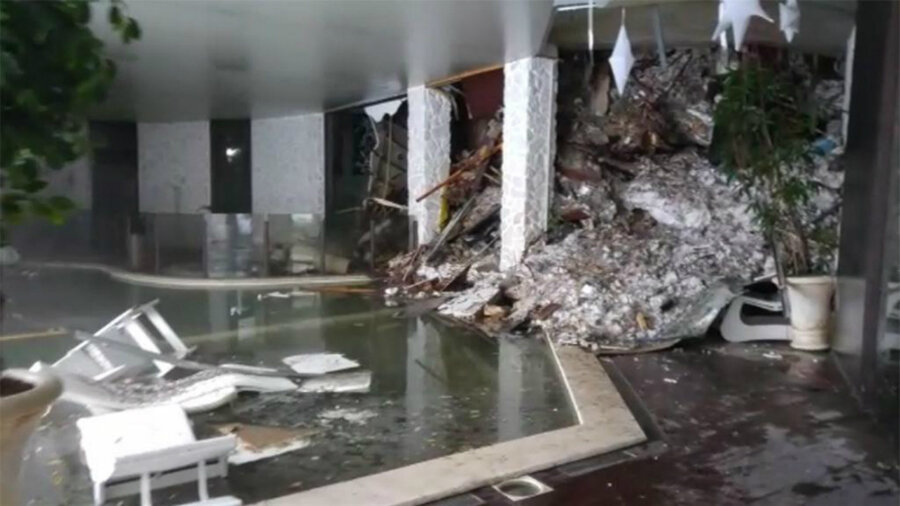Earthquake in Italy triggers avalanche, buries hotel
Loading...
With 16 feet of snow stopping plows and ambulances in their tracks, Italian rescue workers took to skis to access a luxury mountain hotel buried in an avalanche.
Some thirty guests are believed to be been trapped inside the four-story Hotel Rigopiano in Italy's central Abruzzo region. The avalanche may have been triggered by powerful earthquakes that struck Italy on Wednesday, continuing a string of recent quakes extending back to August of last year.
Many rescue vehicles attempting to reach the hotel, which is located at an altitude of nearly 4,000 feet, have become stuck 5 miles away, in the heavy snow, according to local news network Sky TG24.
One guest, Fabio Salzetta, who managed to escape, described the scene in a text message: “Some walls were knocked down,” reports daily newspaper Corriere della Sera. “I’m outside with a maintenance worker but you can’t see anything of the hotel, there’s only a wall of snow in front of me.”
First responders arrived on skis at 4:30 a.m. local time, using helmet-mounted flashlights to navigate their way through blizzard conditions. Helicopters followed shortly after. "We're dropping our rescue units down by helicopter and they are starting to dig," said Luca Cari, spokesman for the national fire brigades, Reuters reports. So far, two people have been found alive, but fatalities are expected.
"I am alive because I went to get something from my car," one of the two survivors, Giampiero Parete, told medical staff, according to la Repubblica.
Mr. Parete, who was vacationing at the hotel with his family, had attempted to sound the alarm shortly after the incident, calling his employer, Quintino Marcella, and asking him to alert authorities, Mr. Marcella told the Associated Press.
"He said the hotel was submerged and to call rescue crews," Mr. Marcella said, adding that his calls to the police and the local prefect's office went unheeded. "The prefect's office said it wasn't true, because everything was OK at the hotel."
Some locals expressed frustration with the scale of the rescue operation.
"We have been abandoned by everyone!" exclaimed Daiana Nguyen, a resident from a nearby province, on Sky TG24. "They talk about sending in the army: Thirty to 40 men came with shovels. We need heavy machinery."
Rescue workers shared similar sentiments, daunted by the scope of the avalanche.
"We haven't been able to do too much. The structure has collapsed. It's more like a pile of rubble than a hotel," said Antonio Crocetta, a member of the Alpine Rescue squad.
"What is left of the hotel is in danger of collapse. The hotel is almost completely destroyed. We've called out but we've heard no replies, no voices. We're digging and looking for people," he told Reuters on the phone.
Backup may be on the way. The Italian civil protection authorities say they hope to clear the roads and get rescue vehicles to Hotel Rigopiano soon.
Three powerful quakes that rocked central Italy Wednesday morning are suspected to be the cause. As The Christian Science Monitor reported:
The three strongest quakes had a magnitude of 5.3, 5.7, 5.3, and a depth of about six miles, according to the US Geological Survey. More than 50 aftershocks were detected within the hours after the last of the three strong tremors, nine of which were measured above magnitude 4.
These quakes are the latest in a wave that has rattled Italy since last summer, literally altering the landscape.
The quake comes four months after a tremor struck the same regions in August, killing 300 people and destroying thousands of homes and businesses, and two months after a 6.6-magnitude quake – the biggest one in 36 years in the country – rattled the region....
Since last August central Italy has felt more than 45,000 aftershocks, which have reshaped more than 230 square miles of land and lowered some areas by up to 28 inches, Italy's National Institute for Geophysics and Volcanology said.
Some wonder if more could be done to minimize damage in such an earthquake-prone region. According to Leopoldo Freyrie, president of the National Council of Architects, more than half of Italian homes were built before antiseismic standards.
“The danger lies not so much in ancient monuments, as in the buildings constructed between the late 1940s and the early 1970s: These tend to be very dangerous,” he explained to Monitor correspondent Anna Momigliano in 2012.
But that’s a task for another day. For now, residents of central Italy are just trying to come to terms with the tragedy.
"I don't know if we did something bad. That's what I have been asking since yesterday," Amatrice Mayor Sergio Pirozzi told the AFP news agency. "We have got up to two meters of snow and now another earthquake. What can I say? I have no words."
This report uses material from Reuters and the Associated Press.







